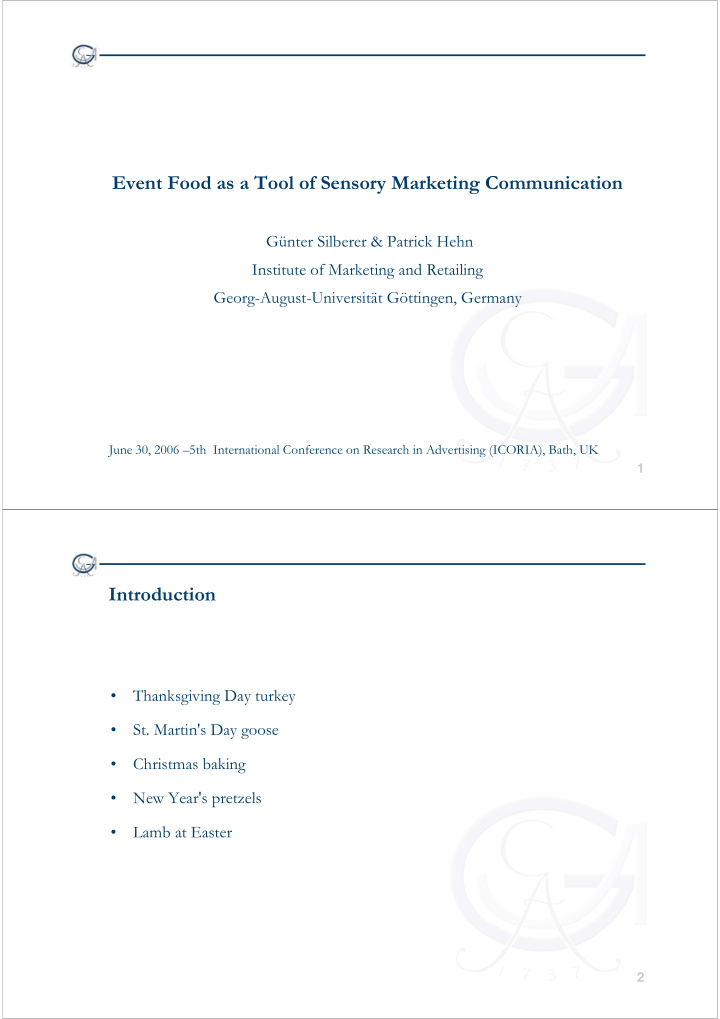



Event Food as a Tool of Sensory Marketing Communication Günter Silberer & Patrick Hehn Institute of Marketing and Retailing Georg-August-Universität Göttingen, Germany June 30, 2006 –5th International Conference on Research in Advertising (ICORIA), Bath, UK 1 Introduction • Thanksgiving Day turkey • St. Martin's Day goose • Christmas baking • New Year's pretzels • Lamb at Easter 2
Introduction • FruchtZwerge-Drink for 1998 FIFA world cup • Kraft Foods chocolate for 2006 FIFA world cup • Stabinger world cup cake for 2006 FIFA world cup • Pulmoll world cup candies 2006 3 Fig. 1 The „FruchtZwerge-Drink“(right) on the occasion of the FIFA world cup 1998 Source: Danone GmbH, Haar 4
Fig. 2 Milka „Fußball-Mix“ on the occasion of the FIFA world cup 2006 Source: Kraft Foods Germany, Bremen 5 Fig. 3 Milka „Champiolade“ on the occasion of the FIFA world cup 2006 Source: Kraft Foods Germany, Bremen 6
Fig. 4 Filled world cup cake with mascot and official FIFA logo Source: Stabinger Football GmbH/Srl, Sesto 7 Fig. 5 Sugar free Pulmoll world cup candies Source: Kalfany Bonbon GmbH & Co. KG, Müllheim 8
Players event organizers → event marketing • event sponsors → company marketing & food sales • food producers → company image & food sales & cross selling • 9 Objectives events as a chance to present products „in a festive, emotionally charged atmosphere“ (Gobé 2001) event image → food image image transfer 1: image transfer 2: food image → corporate image 10
Target groups • visitors of the event • parties interested in the event (media audiences) • people mainly interested in event food (innovative food consumer) 11 In-house corporate events: • executives • employees and their families • key accounts • preferred suppliers 12
Choice of products • picking up on contemporary food trends such as healthy eating • new sensory characteristics - novel flavours - novel sound ( → sweets that start to crackle when sucked) • new symbolic system including - product design - package design - branding 13 Choice of events - historically established events like Christmas and Easter - established events like world championships, Olympic Games, and festivals - new events like anniversaries of a town - PR events hosted by a company on anniversaries and other occasions 14
Product-Event Affinity - obtaining the right product-event affinity is crucial initial step “event choice” → how to find the right product - initial step “product choice” → how to find the right event - - Product-Event-Affinity depends on beliefs and attitudes in the target group(s). Therefore affinity can be analyzed by interviewing the target group(s). 15 Correspondance Analysis - Correspondence Analysis depicts products and events in a common subspace (Greenacre 1993) - Correspondance Analysis therefore helps to recognize and to interprete product-event affinity (Scharf & Volkmer 1999). - The mapping presented in Fig. 6 is based on a survey of 48 people. - The two axis depicted explain 37 % and 49 % of the total variance (13 % information loss caused by reduction to two dimensions). 16
Fig. 6 An example of product-event-affinities – Findings from a correspondence analysis Source: Scharf and Volkmer (1999) 17 The use of event food as a marketing mix • product policy: - novelty and suitability - sensory experience & outward appearance - storability & transportability • distribution: - catering for event visitors - distribution in distribution channels before and while the event 18
The use of event food as a marketing mix • pricing: - price level - price differentiation (targed groups & distribution channels) - price dynamics (price reductions after the event) • communication: - point-of-event communication - point-of-sale communication - mass media communication (e.g. including sponsoring communication) - special interest media communication (life-style, food, media, sport media) 19 Summary • Event Food is a traditional version if cause-related marketing and constitutes a growing part of our festive culture. • Creating Event Food gives the opportunity for image transfers – from event image to product image and from event food image to the company’s reputation. • Successful event food implies a balanced marketing concept: the balanced mix of product policy and branding, distribution, pricing, and communication. High product-event affinity and the combination of marketing and sensory expertise play a crucial role. • Event food experiences can benefit to many other marketing or communication tasks. 20
Thank you for your attention and for your comments! 21
Recommend
More recommend